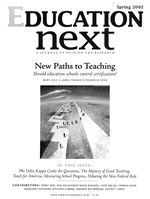Although September 11 briefly arrested the nation’s work on domestic issues, 2002 is still shaping up as a significant year for education reformers.
When President Bush affixed his signature to the No Child Left Behind Act on January 8, 2002, he arguably brought to life the most important piece of federal education legislation since 1965. For the first time, Washington would now require all states, in exchange for federal dollars, to demonstrate measurable progress in student learning. As Siobhan Gorman shows, in a domestic version of “Nixon goes to Beijing,” it was a Republican administration that decisively expanded the federal role. Congress and the president have placed a new and only partially funded mandate on state and local governments-the kind of measure that congressional Republicans, just a few years ago, were swearing never to do again. Resistance to this new mandate came mainly from those on the Democratic side of the aisle. These one-time proponents of a strong national role in education managed to water down the law’s accountability provisions to the point where it remains unclear whether the legislation’s promise will be realized. Michael Kirst’s essay on the ups and downs of California’s accountability efforts should give pause to any who take for granted that the new federal law will be implemented.
Many of those implementation issues involve the arcane matter of measuring progress. Ordinarily, yardstick questions are left for discussion in the halls of statistics departments, but the topic has become so pressing that we have devoted this issue’s Forum essay, “Accountability Gains,” to “value-added” measurement. The theory seems straightforward: determine how much a student learned in a given year by subtracting from his or her most recent test scores the results of the previous year’s tests. Would that it were so simple. Measuring a student’s performance twice is an invitation to make two mistakes. Classroom noise, illness, confusing instructions by an inexperienced teacher, too much help from the teacher-coach-these and many other elements can confound the measurement. All the forum participants acknowledge the problem, though they disagree about its implications for testing policy.
The year is shaping up to be momentous for the school choice movement as well, though again the long-term implications remain misty. On February 20, the U.S. Supreme Court heard oral argument regarding the constitutionality of the Cleveland voucher program. That the justices allowed 80 minutes for argument, instead of the usual 60, was just one measure of the case’s significance. It was the questioning of Justice Sandra Day O’Connor, widely regarded as the swing vote in this case, that received the closest attention. To some veteran observers, the case was decided when she commented: “If anything, [the law is] skewed against the religious schools.” Still, no one will know for sure until the court hands down its decision, probably in May or June of this year. Joseph Viteritti’s Feature essay “Vouchers on Trial” tells us that even a decision allowing the Cleveland program to proceed will be followed by much litigation over the many state-created “walls of separation.” Meanwhile, as William Howell explains in his review of recent overviews of school voucher research in “Data Vacuum,” we can look forward to a continuing flow of “objective,” “reasonable,” and “comprehensive” summaries of recent research, each written authoritatively from a particular ideological perspective.
The issue contains still more. Joel Best in “Monster Hype” shows how statistics can be used to distort the public’s perception of the amount of violence and bullying in our schools. Caroline Hoxby’s Research essay “The Power of Peers” is a creative test of the widely accepted proposition that students’ peers affect how much they learn. Predictably, they do-but not always in the ways you might have expected. Jeffrey Mirel in “Unrequited Promise” tells the fascinating story of how New American Schools evolved from an ambitious plan to foster education change into a Beltway enterprise dependent largely on federal grants. In the Check the Facts essay “Waiting for Utopia,” David Murray explains how One Big Idea shapes the commentary of Richard Rothstein, whose writings appear on the news pages of America’s most influential paper.
-The Editors





